
surfresearch.com.au
tracks : surfboard guide, 1977.
tracks : surfboard guide, 1977.
|
|
|
|
|
|
 |
surfresearch.com.au
tracks : surfboard guide, 1977. |
| Dick Van Straalen : Second-hand | Mickey
Mac
: Custom |
Steve Artis : Flutes. | Surf Sure: Rail Saver. |
| The
beginner usually falls into one of two
categories. One has been associated with the beach and the sea for some time, and has maybe been riding a mat or coolite board before deciding to try surfboard riding. The other group has no ocean experience, they're completely new to the beach and the sea. The two types of beginners need a completely different kind of board to learn on. If you're a newcomer to all surfing activities you should look for a board which offers good stability and flotation since, to the complete beginner, good balance is the hardest and first obstacle to conquer. At first you will find it difficult even just to lie on the board and paddle it through the water while keeping your balance. You should therefore look for a wider, stable board, full in the planshape (that is with a widish round nose and a round tail) with plenty of thickness so that it will paddle and catch waves easily. The rails should be very, very soft and roundish. Hard edges in the rails will only hand you up by "catching" or digging in. A rough guide to the size of board you need can be calculated from your weight A 100 lb novice surfer should get a board around 6'6", a 140 lb surfer should get a 7'0", and a 180 lb surfer a 7'6". When you're choosing a second-hand surfboard (which is the usual course of action for a beginner) check carefully the condition of the board. Look for cracks around the base of the fin and make sure the fin is secure. Have a look to see that the glass is not "lifting" or coming away from the foam, and that any holes (dings) in the board have been mended properly. Leaking dings can be spotted by a brown discolouration of the foam by sea water. After you've checked the shape and condition of the board pick it up and hold it under your arm. If the board feels nice to you that will help you to learn to surf—it's important to your mental attitude that you like the looks and feel of your board You're going to spend a lot of time together. If you are a beginner who already has some experience of surfing, either on a surfoplane, mat or coolite, the transition to stand-up surfing should be a bit easier since you will already have the feeling of balance when paddling and you'll be a lot more familiar with waves and the water. If you weigh around 100 lbs or less you should be looking for a board about 6 feet long, preferably a round tail, but with nice thin round rails. It should have an even foil and rocker (bottom curve) but a slightly thinner tail. This kind of board is just slightly more sensitive than the complete learners machine. Nevertheless the board should be reasonably wide (19 1/4"- 20") and have enough thickness for your to paddle it easily. In summary, the beginner who has no previous experience of the surf should look for a slightly longer, fuller, rounder and thicker board than the novice who has been playing in the waves on mats or coolites. The beginner with a little experience should look for a slightly more sensitive board (but not an advanced high performance board) which could be a round tail or swallow tail, slightly shorter and not quite as thick or as full in the planshape. Dick Van Straalen |
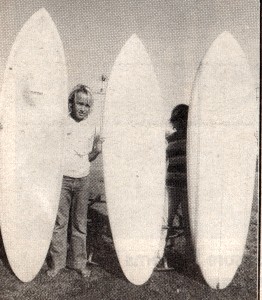 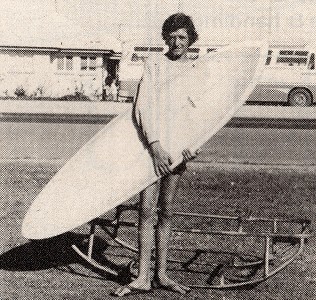 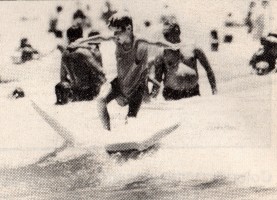 |
| Custom Built As a newcomer to surfing, the beginner faces an immediate problem when it comes to buying that first surfboard. When you walk into the surfboard showroom you're confronted with an array of surf-boards both new and secondhand. It can be hard to pick one out if you don't know what kind of board you'll need to learn to surf easily, and without problems caused by your equipment. One way to overcome this problem of choosing a board is to have one made personally for you. This is known as having a board "custom built", and the way to do it is to go to a board factory and (don't be shy) ask to speak to the shaper. A good shaper will ask you a few questions about how much time you've already spent in the waves, (either on mats or coolites or on borrowed surfboards) and he'll make a note of your height and weight. From this information the shaper will be able to produce a board on which you'll be able to learn in the confidence that you've got the right equipment. Whatever you do, whether you buy a board second hand, new from the showroom rack or custom built, stay well clear of radical or advanced surfboards—these are for the experts only. And do take advice from people who make surfboards and therefore know what they're talking about. Assuming you're in the 9-14 year old age group (which applies to most beginners) and you're of average height and weight, the board I would be shaping for you would be around 6'6" in length, and 20" wide. It would have enough thickness to float you easily but not too thick. An over-thick surfboard is too buoyant and behaves bouncily, like a cork bobbing on the water. |
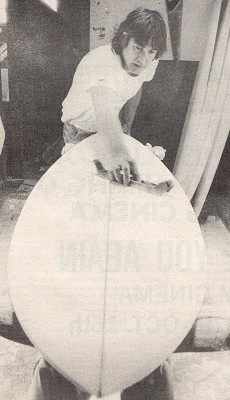 |
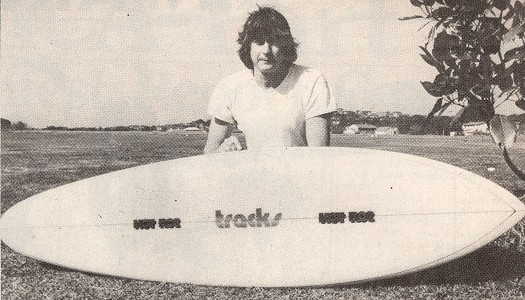
|
"Mickey Mac" McCahon shapes Hot Roc surf boards in Brookvale, the heart of Sydney's surf board industry—Ed. |
|
DESIGN
WITH A TOOT ON THE FLUTE: After surfing double winger area pins for over twelve months and continually refining the design. I've hit on something which is giving the boards a little something extra in their performance; flutes under the wings. Flutes. I've seen them before and so have you but I know nothing of the history of this refinement. My first real contact with the idea came just before this year's Coke contest when I sanded a couple of boards-for Reno Abellira. Reno has been putting flutes under the wings of his shooters for some time and I remember well how particular he was to have them sanded with acute precision. When the time came for a new surfboard for myself I decided to give the flutes a toot. |
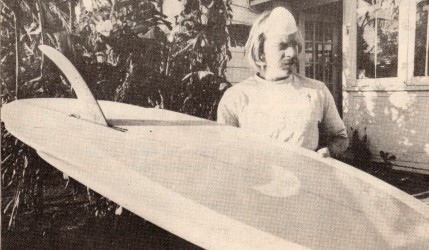 |
Sequence: Hodgeman Mat Rider, ? See: George Greenough : Surf Mats. Tracks, January 1977. and Hodgman Surf Mat #375 |
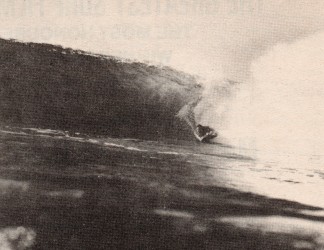 |
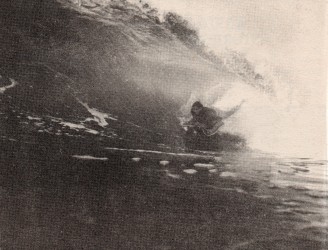 |
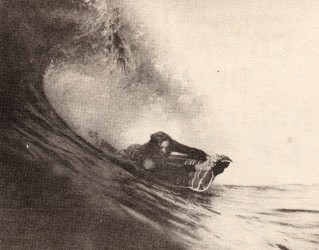 |
Page 21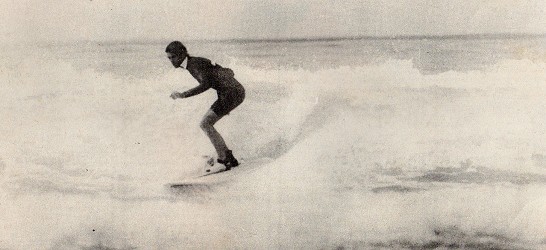 Standing.knee-boarder Peter Crawford. Photo: Martin
Tullemans.
Rail Saver by Sure Surf Supplies
PO Box 85 Torquay 3228 $2.00 by post. By the 1980s, commercial leg-ropes came fitted with a rail saver. |
Page 29
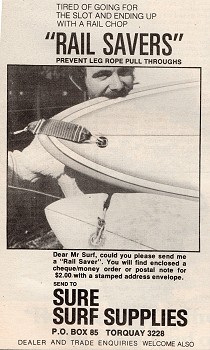 |
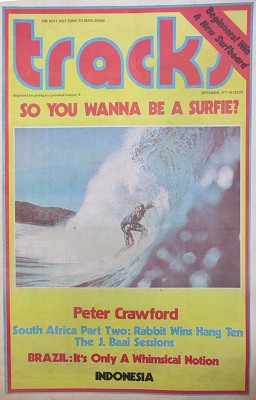 |
|
|
|
|
|
|